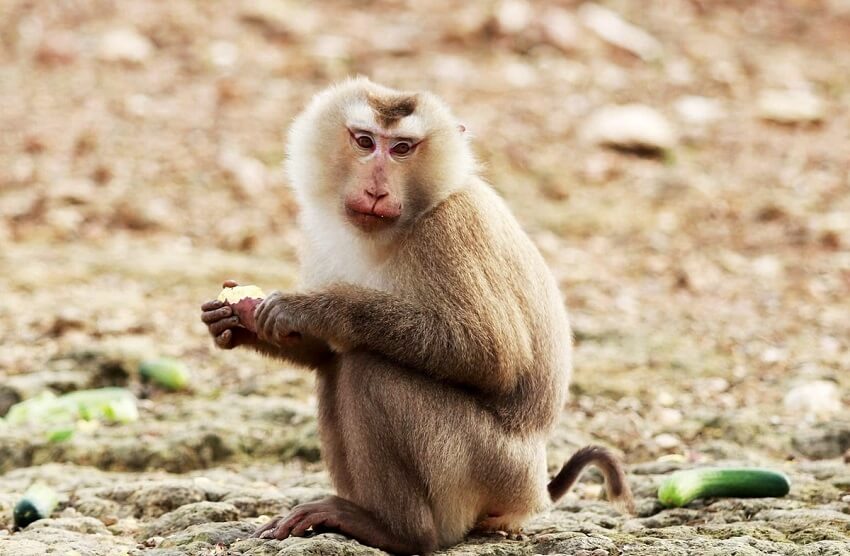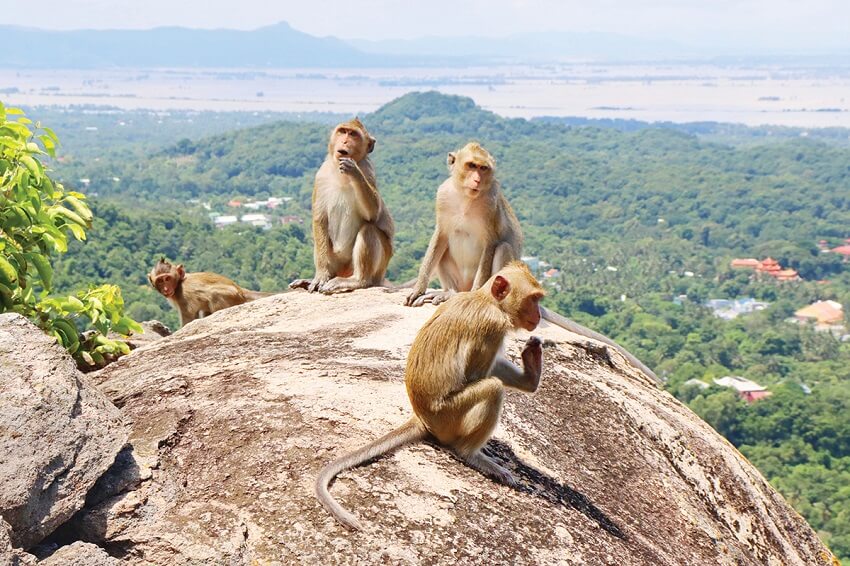Monkeys are considered one of humanity’s closest relatives, and most of us believe we know a lot about them. However, the following information might surprise you about these intelligent and active animals. Join KnowAllAnimals as we explore 47 Interesting Facts About Monkeys That Will Surprise You in this article.
1. 47 Interesting Facts About Monkeys That Will Surprise You
Let’s dive into some interesting facts about monkeys:
1. The origin of the word “monkey” is unclear. It may come from the word “Moneke,” the name of Martin Ape’s son in a medieval animal story. It is also believed to be related to the Dutch word “Manneken,” meaning dwarf.
2. There are currently 264 species of monkeys.
3. Monkeys can be divided into two groups: Old World monkeys, which live in Africa and Asia, and New World monkeys, which live in South America.
4. A baboon is an Old World monkey, while a marmoset is a New World monkey.
5. Some monkeys live on the ground, while others live in trees. Different monkey species eat different foods, such as fruits, insects, flowers, leaves, and reptiles.

6. Most monkeys have tails.
7. The smallest monkey in the world is the Pygmy Marmoset, with an adult male weighing from 120 to 140 grams (4.2–4.9 ounces). The largest monkey in the world is the Mandrill, with an adult male weighing up to 35 kg (77 lbs).
8. Capuchin monkeys are thought to be one of the most intelligent New World monkey species. They are able to use tools, learn new skills, and show different signs of self-awareness.
9. Monkeys understand the concept of fairness. They also know how to weigh what’s better against other things, but are not influenced by social and economic standards.
10. To communicate, monkeys use facial expressions, sounds, and body movements.
11. The brain structure of monkeys and humans is similar. New research has revealed that the human brain has many similarities to the monkey brain. The monkey brain is also used to control language and complex thoughts, and the way our brains process problems is the same.
12. Monkeys show affection and a bond with each other through grooming.
13. Trees, grasslands, mountains, forests, and high plains are the most common places where monkeys live.
14. Monkeys carry hepatitis, tuberculosis, and herpes B viruses.
15. Most monkeys eat both plants and animals. Some monkeys also eat filth.
16. New World monkeys have 36 teeth, while Old World monkeys have 32 teeth.
17. South American Titi monkeys are monogamous. They become distressed when one of them dies. They show affection by kissing, cuddling, holding hands, and grooming each other.

18. The biggest monkeys are howler monkeys. Their howls can be heard for about three miles in open areas and two miles in the forest. They spend 80% of their time resting.
19. The language of monkeys is no less complex than human language. New research has shown that the language of monkeys is more complex than we thought. Monkey language is as complex as human language and has many variations. Monkeys can use simple sounds to create complex sentences.
20. Red Colobus and Olive Colobus monkeys are hunted for meat by both humans and chimpanzees.
21. Squirrel monkeys can make more than 20 different sounds.
22. By urinating on their subordinates, South African monkeys assert their dominance.
23. The proboscis monkey was voted the ugliest animal on the planet, ranking third on the list of ugliest animals. It has a large, pot-bellied stomach because its stomach is divided into several compartments, each containing a different enzyme to digest food. Because tree leaves do not have many nutrients, the monkey spends all day picking leaves to fill its multi-compartment stomach, which makes its belly even bigger.
24. The large, 18-cm-long nose is the tool that proboscis monkeys use to court females. Thanks to this nose, proboscis monkeys can make sounds that can be heard for hundreds of miles.
25. New World monkeys have no thumbs, including spider monkeys and squirrel monkeys.
26. There were 81 species of New World monkeys in the Amazon River basin in 2008, but new species are still being discovered.
27. Old World monkeys have large cheek pouches, which help them eat quickly and store food to swallow later.
28. 96 is the number of Old World monkey species.
29. Monkeys do not eat banana peels.
30. Monkeys are easily distinguishable from apes. Monkeys have tails, apes do not.
31. The spider monkey has an unusual tail. Its tail can support the weight of its entire body.

32. Do not try to touch a monkey. They don’t like it and may attack you.
33. Monkeys are intelligent animals with an IQ of 174.
34. Common Ancestry with Humans
In the past, there were many who believed that monkeys were the ancestors of humans. This view sparked much debate in both the scientific and religious communities. However, scientists have now confirmed that monkeys and humans only share a common ancestry and both belong to the primate order. Within this order, chimpanzees—which are considered the most similar to humans—emerged along with the Old World monkeys 25 million years ago.
35. Monkey Meat Is Considered “Highly Nutritious”
In many East Asian countries, monkey meat is considered a “highly nutritious” food that helps boost male vitality and enrich the blood. In traditional medicine, doctors even use monkey bones to make remedies to treat many diseases. However, the true medical benefits of monkey meat are still a topic of debate in the medical field.
36. Monkeys Are a Great Help to Humans
In the coastal province of Surat Thani, Thailand, locals have developed a unique way of harvesting coconuts. They train monkeys to do this job for them. The monkeys are expertly taught how to avoid ropes and how to recognize ripe coconuts.
37. Monkeys Are Worshipped as “Monkey Gods”
In Indian religious culture, there is a famous monkey god named Hanuman, whose weapon is a mace, a symbol of courage. The monkey god Hanuman is the central character in two of India’s great and famous epics, the Ramayana and the Mahabharata.
38. The Copyright Battle Over a Monkey’s Selfie
The website Wikimedia once rejected a photographer’s request to take down a picture that he claimed was used without his permission. Wikimedia’s reason was that the copyright belonged to the monkey who took the photo.
39. Bonobo Monkeys Are Often Referred to as “Sexually Promiscuous Apes”
In this monkey species, females use sex for many purposes: to reduce stress, resolve conflicts, and even to form alliances among females to stand up to males.
40. The Burmese Snub-Nosed Monkey Has the Smallest Population
This species of monkey is very good at predicting storms because they tend to… sneeze when they breathe in rainwater. However, this also happens frequently because their snub nose is… upturned.
41. The Presbytis hosei canicrus Is an Endangered Monkey Species
The monkey with the official name Presbytis hosei canicrus has been placed on the International Union for Conservation of Nature’s list of endangered animals due to habitat loss from agricultural development, mining, forest fires, and excessive hunting. It is believed that this monkey species only lives in the forests of northeastern Borneo, which borders the island of Java in Indonesia.

42. Monkeys Can Remember Faces
Research shows that humans and monkeys both have the ability to recognize faces. Monkeys use holistic processes to recognize a face.
43. Monkeys Can Recall Memories
Studies have shown that monkeys have the ability to recall memories just like humans. Scientists conducted an experiment with monkeys and concluded that monkeys have a memory comparable to that of humans.
44. Snow Monkeys Have a Thick Coat
Snow monkeys in northern Japan have a thick coat of fur to keep warm and live near hot springs. The social hierarchy of snow monkeys is determined by the position and order in which they sit when they soak in the hot spring.
45. Tarsier Monkeys Have Enormous Eyes
The Tarsier monkey is a nocturnal animal with very large eyes, which are almost the same size as their brain. This allows them to see everything at night.
46. Golden Monkeys Are Mischievous
Golden monkeys have a lot of mischievous tricks and are a real nuisance to us. These animals have invaded villages in India, breaking into houses to steal food and climbing up tall buildings to escape.
47. Capuchin Monkeys Are Cautious and Intelligent
To identify enemies, Capuchin monkeys use different sounds. Some organizations train Capuchin monkeys to help in the care of infants and people with severe spinal cord injuries or mobility issues. Capuchin monkeys are skilled at using tools and are quite agile, using tree branches to poke into rock crevices to get food, smashing hard nuts with a rock, and removing hair and spines from caterpillars by rubbing them on a tree branch.
2. Final Words
We hope this information from Know All Animals has helped you learn more about Interesting Facts About Monkeys. Thank you for reading our article.
References: https://en.wikipedia.org/wiki/Monkey



